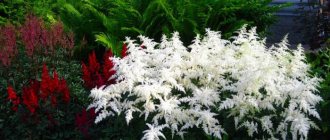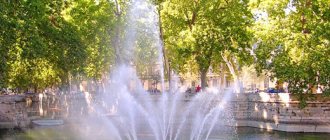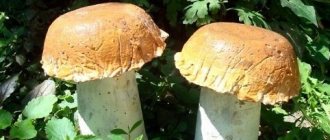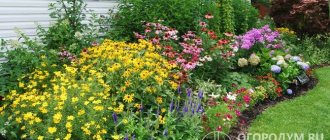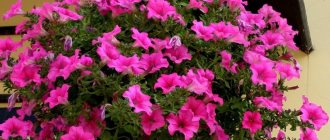general information
Petunia is a bushy ornamental flower with creeping or straight shoots. It has expressive oval leaves up to 12 cm in size and a deep dark shade. Most often, the plates are pubescent, and bright petals look especially elegant against their background.
Petunia bushes can grow up to 0.7 m, but there are very tiny varieties up to 15-20 cm. On short peduncles, funnel-shaped flowers with regular or double inflorescences open wide. When growing indoor varieties, keep in mind that petunia flowers can have a very strong smell.
Breeders and gardeners have been dealing with petunias since the eighteenth century. The now popular hybrids began to be bred about a hundred years ago to decorate the balconies of mansions. Then they migrated to flowerpots, and soon filled the gardens.
Photo: pixabay.com
How to water correctly
You need to water with settled water at room temperature. After some time, they are picked and transplanted into separate small seedling or peat pots. Picking is carried out after the appearance of three or four true leaves.
To prevent strong stretching of seedlings, the pots are moved to a darker, well-ventilated place.
A month after transplanting, the pots with young seedlings can be taken out onto the balcony or veranda. For hybrid forms, as well as plants that grow quickly, for better formation of bushes and abundant flowering, it is necessary to pinch the shoots at the level of 4-5 pairs of leaves.
The sooner you pinch, the more new shoots will appear on the bushes. The second pinching is carried out when the length is about 20 cm. Further pinching is carried out as it grows. After the seedlings have grown a little, you can fertilize them with complex nutrient mixtures.
Types of petunia
All varieties of petunias are divided into two large categories - multi-flowered and large-flowered. They are also called multiflora and grandiflora, respectively. There are several intermediate categories and a whole garden group that covers dozens of different subspecies.
Petunia Fantasy
This is a compact variety from the multiflora category with red, crimson, salmon and pink flowers. Less common are purple, white, blue and cream hybrids. Multiflora petunias bloom earlier, are not picky and are better suited for gardens. The diameter of the flowers is about 5 cm, but there are a lot of them and they are unpretentious.
Photo: rotarygardens.blogspot.com
Petunia Plum Crystal
An interesting feature of Plum Crystal petunia is its ability to change the shade of its petals. Gradually they fade from lilac to almost whitish. The flowers are decorated with dark and expressive burgundy-violet veins.
Photo: oir.mobi
Petunia Dormouse
Dormouse is a floribunda petunia with large flowers that look especially good in a mass. The series is notable for its wide variety of colors. For example, raspberry or burgundy with a white center or pale lilac with dark purple streaks.
Photo: solo-semena.ru
Petunia Picoti
Large and expressive ruffled flowers are the main feature of this small category of grandiflora petunias. Bushes up to 25 cm will be an ideal decoration for terraces, gazebos and open balconies. The rich crimson-red or violet-blue hue is emphasized by the white edging.
Photo: oir.mobi
Petunia Celebrity
Another series of floribunda petunias is notable for its unusual colors. It includes varieties with two-color or three-color petals. They are resistant to rain and heat, so they get along well in the garden or open boxes.
Photo: fedsp.com
Petunia Surfinia
Small garden petunias Surfinia are also called balcony petunias, although the series includes varieties of different sizes. The diameter of tiny Mini Pink flowers is up to 0.5 cm, and large hybrids are up to 9 cm. The palette has all possible shades, except yellow-orange.
Photo: oir.mobi
Tree hydrangea: varieties, care features (60 photos)
Ampelous petunia: how many seedlings should be planted in a pot and at what distance from each other?
You can plant 2 petunias in a 10 liter pot. These plants have roots that grow well; they may not have enough space in the future. One plant should be planted in a small 5 liter pot.
It is worth understanding that such plants should be trimmed in time and dried flowers removed. Otherwise, the plant will begin to wither. In addition, the number of flowers may be reduced. As soon as you notice that the leaves and flowers are withering, cut off ¼ of the branches.
Ampelous petunia: how many seedlings should be planted in a pot and at what distance from each other?
Petunia care
It is difficult to find a more versatile flower that can be equally successfully grown on a window, in hanging flowerpots, balcony boxes, greenhouses and gardens. Except that in our climate, perennials in open ground turn into annual varieties.
Temperature
Petunia really needs warmth - and this is precisely the reason why it does not winter in our climate. The ideal temperature for germination is above 23 degrees. Be sure to avoid sudden changes and always accustom the flower to new conditions gradually. Ideally, during the day it should be about 18-20 degrees, and at night - at least 15.
Photo: dachnaya-zhizn.ru
Lighting
Petunia loves light very much, and this is a fundamentally important criterion for flowering. Therefore, if you plant seedlings at the end of winter, they will most likely have to be illuminated with phytolamps. If the seedlings are too dark, they will grow weak and sickly, and mature bushes will begin to wither.
Photo: u-florista.ru
Watering
Petunias need moderate watering because both extremes are fraught with problems. If the soil dries out too much, the flower will dry out along with it, and due to excess water the plant will rot. Pour water carefully, because it is important not to flood the stem and leaves.
Photo: 2sotki.ru
The soil
Petunias definitely need loose soil based on deciduous soil or turf. You will need good fertilizers to help the soil absorb nutrients. Add sand and peat to the substrate to provide it with the desired loose texture.
Photo: rastenievod.com
Fertilizers and fertilizing
Like all flowering plants, petunias need regular, systematic feeding. Already a week after planting, the first portion of fertilizers is applied to the ground, and the next - every week and a half until the end of summer. Occasionally, instead of ready-made complex fertilizers, apply organic fertilizers. Keep in mind that fungal diseases often develop due to manure.
Photo: comfortclub.ru
Transplantation and propagation
If you have enough warmth and light, then ampelous and double varieties can be propagated by cuttings all year round. Take apical cuttings with 4-6 leaves and tear off all but the top two. After this, plant the cuttings immediately in the seedling substrate, but for the first time sprinkle them with perlite on top.
Young petunia shoots take root in 1-2 weeks, depending on the variety and conditions. Grow them in separate pots and pinch them as they grow so that they bush beautifully in the future. By the way, after pinching, cuttings can be used again as cuttings for propagation.
If you are growing seeds, sow them in February (with lights) or late March (without). Combine them with sand and spread them over the moistened substrate. Leave the boxes in a warm place under glass or transparent film for at least a week, until the first seedlings sprout. Don’t forget to ventilate your improvised greenhouse a couple of times a day.
Photo: 2sotki.ru
Wintering
Petunia is a perennial, but to preserve it, you will have to dig up the flower by mid-autumn. Trim all the shoots, transplant the bush into a pot and move it to a cool, dark place with infrequent watering. At the end of winter, place the flowerpot on the windowsill, gradually increase the frequency of watering and gradually introduce the petunia to the daily rhythm of life.
Photo: posaju.ru
Hydrangea (80 photos): types and features of care
Varieties
With colors arranged vertically
Kinds
Based on the type of construction and method of fastening, we can distinguish:
- Ground-based are vertical compositions that are placed directly on the ground. The most popular example of such a flower bed is an alpine slide. Such a flower bed is constructed using stones and earth. The stones are stacked in the shape of a pyramid.
- Climbing structures are structures that rest on walls. Such flower beds include a composition in the form of a screen. It is decorated with climbing plants and decorates a fence, porch, gazebo.
- Hanging are compositions that are hung from above. A striking example of such a design is a raised flower bed. It is made from various available materials (buckets, flowerpots, etc.).
- Wall-mounted are compositions that are fixed to wall surfaces. In such flowerbeds, only petunias can be grown, intended specifically for flowerpots that can bloom in a small amount of soil.
Advantages and disadvantages
Advantages:
- To create a flower bed, a minimum amount of space is required.
- These flower beds are quite easy to care for. For example, having built a compact flowerbed, you do not need to pull out a long hose to water it; you can simply leave it not far from the flowerbed.
- Flowerbeds are easy to store, they do not take up much space, and are easy to assemble and disassemble.
- Vertical compositions can be used for several seasons.
- Flowerbeds assembled with your own hands look creative and unusual, because every gardener sees the composition in his own way.
- Vertical flower beds are easy to transport around the site.
Disadvantages : vertical compositions do not allow the use of a sufficient amount of soil necessary for long-term moisture, so the flower beds must be watered and fed frequently.
Pest and disease control
The main pest of petunia is spider mites, which are difficult to notice until there are too many of them. There are also thrips that leave dried whitish streaks on the leaves. And the third invisible enemy is aphids, which provoke the appearance of fungus and infections. The control mechanism is the same in all cases - timely and regular treatment with insecticides.
Powdery mildew is a type of fungus that appears as a white coating on the leaves. Gray rot develops due to excess moisture or improper care. Blackleg is a rare aggressive disease that literally “burns out” seedlings. With such diseases, it is fundamentally important to urgently stop their spread and remove all damaged plants.
Photo: zverjata.ru
Ageratum (70 photos): types and features of care
First, a little theory
To understand some of the intricacies of caring for these plants, we need to remember certain botanical concepts.
The first concept is a growth point. This is the name of the uppermost part of any plant. There are germ cells that are capable of dividing very actively. It is thanks to this property that the plant increases in length.
But what if you don’t need a tall flower, if you want a compact bush? How to make your green pet grow wider? There is only one answer - you need to wake up the lateral kidneys. The plant always has them, but for the time being they sleep. How to stir them up?
Now we need the second concept - pinching (or pinching, or pinching the tops). This is the removal of the upper part of the young shoot, which will awaken the lateral buds and cause increased growth of adventitious shoots.
Petunia – photo
Petunia is a bright and hardy plant that causes almost no problems, but at the same time decorates the garden. Look how beautiful and impressive it looks in the flowerbed until late autumn!
Photo: oir.mobi
Photo: goodfon.ru
Photo: petunii.ru
Photo: zen.yandex.ru
Photo: teplica-one.ru
Photo: greensotka.ru
Photo: solo-semena.ru
Photo: vk.com
Photo: pxhere.com
Photo: oir.mobi
Photo: stroy-podskazka.ru
Photo: fruitree.ru
Photo: art-pen.ru
Photo: mir-ogorodik.ru
Photo: sm-news.ru
Photo: pixabay.com
Photo: botanichka.ru
Photo: plantclub.com.ua
Photo: domashniecvety.ru
Photo: kpravda.ru
Photo: infourok.ru
Photo: lalend.ru
Photo: t.me
Photo: pxfuel.com
Photo: riafan.ru
Photo: posadkavgrunt.ru
Photo: oir.mobi
Did you like the post? Subscribe to our channel in Yandex.Zen, it really helps us in our development!
Choosing a good combination with other flowers - flowerbed neighbors
Lobelia in a flowerbed gets along well with other flowers. Low plants make the best company. A composition of blue-blue varieties of lobelia, iberis and snow-white alyssum looks harmonious. To create a bright and festive atmosphere, a combination with red-pink balsams, pelargonium and begonia is suitable. You can add low-growing yellow or lemon-colored marigolds.
Lobelia with petunia in a hanging pot
One-year-old lobelia with two-year-old violets
Also, ageratums and petunias coexist perfectly with lobelia, and the silvery glow of cineraria slightly dims the brightness of these flowers. Bellflower, verbena, cloves and salvia are added to group plantings. Ampelous species are combined with ivy shoots, asparagus and chlorophytums.
Cold duet lobelia+begonia


